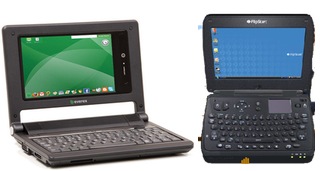Information Week quotes some Gartner predictions in the article…
More Macs, More Mobile, More Open Source, Gartner Predicts
They predict mobile workers will abandon the notebook form factor in favor of what they term new classes of Internet-centric pocketable devices at the sub-$400 level. Believe it or not, people have been making this prediction since the early 1980s with the introduction of the Radio Shack TRS-80 Model 100. I bought one around 1984. Since it was introduced a year earlier in 1983, it is a quarter century old this year! The Model 100 was a great ultraportable and had the best keyboard I’ve ever used on this class of device.
The OLPC and the Asus Eee PC (no, I still haven’t bought one… Maybe I should create a tip jar so I can speed up that process  showed that the market is hungry for a ultraportable notebook. They also showed that people are willing to use Linux in the right package. The shock for many of us is that the personal Linux box finally caught on, but it took the subnotebook form factor to get it accepted.
showed that the market is hungry for a ultraportable notebook. They also showed that people are willing to use Linux in the right package. The shock for many of us is that the personal Linux box finally caught on, but it took the subnotebook form factor to get it accepted.
I’m having a hard time accepting Gartner’s prediction of a pocket-sized device replacing notebooks or subnotebooks though. Why? People still need to get data into the boxes. And, after 15 years of handheld device innovation (using the Newton’s 1993 launch as an arbitrary starting point), we still haven’t got anything better than keyboards for getting a lot of information into a computer. Sure, speech recognition is amusing, handwriting recognition sort of works, and thumb keyboards caused an email revolution. But, a decent sized QWERTY keyboard is the tool of choice for most of us. And, with the average age of the population pushing up as we baby boomers reach middle and retirement age, the screen size can’t shrink much more to sell into that huge market group.
The really interesting twist depends, I think, on the outcome of Microsoft’s attempt to purchase Yahoo. If Microsoft embraces Yahoo as a whole, they will all of a sudden become a huge Open Source player. As a long time proponent of the interoperability of proprietary software (like Microsoft’s) and Open Source software, I think this could be a huge win.
Of course, huge mergers/acquisitions are never easy and always painful. So, this will be an interesting story to watch play out.
 showed that the market is hungry for a ultraportable notebook. They also showed that people are willing to use Linux in the right package. The shock for many of us is that the personal Linux box finally caught on, but it took the subnotebook form factor to get it accepted.
showed that the market is hungry for a ultraportable notebook. They also showed that people are willing to use Linux in the right package. The shock for many of us is that the personal Linux box finally caught on, but it took the subnotebook form factor to get it accepted.